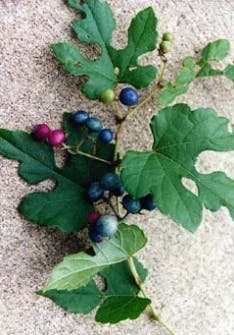Porcelain Berry
Porcelain Berry Identified in North Bennington
Location: Near the Historic Henry Covered Bridge, River Road, north side of the Walloomsac River
Detected by: Vermont Department of Forests, Parks & Recreation – Forest Health Program and the Agency of Agriculture’s Plant Health Section










Overview
Porcelain berry (Ampelopsis glandulosa) has been identified growing in a public natural area near the Historic Henry Covered Bridge in Bennington. This plant is a regulated species under Vermont’s Noxious Weed Quarantine because its introduction and spread pose serious ecological, economic, and community risks.
Originally introduced as an ornamental vine, porcelain berry has escaped cultivation and become a highly invasive plant pest. It spreads aggressively, climbing and smothering native vegetation, altering habitat structure, and outcompeting the plants and trees that sustain Vermont’s ecosystems and working lands.
Why It’s a Problem
Porcelain berry threatens both ecosystem health and property values in Bennington County. Its rapid spread can:

- Outcompete and smother native vegetation, reducing biodiversity
- Alter forest structure and disrupt natural regeneration
- Hinder recreational access and enjoyment of public lands
- Increase long-term management costs for towns and landowners
- Lower property values where infestations make land less usable or visually appealing
- Disrupt wildlife habitat, nutrient cycling, and native pollinator systems
If left unmanaged, porcelain berry can quickly dominate riverbanks, fencerows, and open spaces—making restoration difficult and costly.
Early Detection = Opportunity
This was caught early, and Porcelain Berry is not widespread in Vermont, so this offers a rare opportunity to act early and prevent it from becoming a long-term problem. With coordinated community action, we can protect our forests, farmland, and river corridors before this invasive vine becomes entrenched.
Have You Seen This Plant?
Please fill out this form, and we will be in touch:
How You Can Help
1. Report Sightings
Bennington County Conservation District has our own iNaturalist initiative to compile a catalog of invasive species in Bennington County.
What is iNaturalist?
iNaturalist is an online platform designed to connect people like you to an entire community of nature enthusiasts. Users share sightings of plants, fungi, and animals and in return get identifications on what's in their images (or audio files). All ID's on iNaturalist are consensus-based. This means other users can see your observations, and either agree or disagree with your identifications based on their own knowledge. An observation becomes "research grade" when the majority of identifiers reach a species-level consensus about the plant, animal, or fungi in your picture.

If you think your photo of a plant in your yard isn't important enough to post, think again! All research grade observations on iNaturalist get added to the Global Biodiversity Information Facility, and can then be used in scientific research and publications.
How to Use It
One of the best parts about iNaturalist is that everyone can use it—you don’t need to be a scientist or a professional naturalist. All you need is a computer or smartphone and an interest in the natural world around you!
To get started, create a free account at iNaturalist.org or via the smartphone app. Then, upload identifiable pictures or audio with a location and a date and give it your best ID (if you have no clue, the platform will often suggest what it thinks is in your photo). Within minutes or hours, other users will see your observation and will help to identify it.
2. Join a Volunteer Removal Day
BCCD will be organizing Invasive Removal Volunteer Days throughout the growing season. These events provide hands-on training, tools, and guidance for safe and effective removal.
Sign up to volunteer and help protect Bennington County’s natural and working lands.
3. Manage Plants on Your Property

- Hand-pull vines and roots where possible.
- If full removal isn’t feasible before winter, cut and destroy berry clusters in the fall to prevent seed spread.
-
Do not compost porcelain berry. Instead, arrange for on-site incineration, which ensures that roots, stems, and seeds are fully destroyed.
- The District can assist with safe burn setup and supervision where needed.
If you do not have the tools or physical ability to remove porcelain berry, BCCD’s volunteer team can help with both mechanical removal and on-site incineration support at no cost to landowners.
Spread Prevention Plan
BCCD will be implementing a three-year monitoring and response plan to contain and control porcelain berry within Bennington County. The plan includes:
- Seasonal site monitoring at and around the Henry Covered Bridge site.
- Annual Spring and Fall “Walk the Land” ID Campaigns across the towns near North Bennington to train residents in identification and early detection.
- Volunteer removal and incineration assistance for residents who cannot safely remove infestations on their own.
- Public outreach and mapping to track infestations and direct rapid-response efforts.
These actions will help ensure long-term protection for our natural areas, farmland, and river corridors.
Learn More
For additional information about identification and management:
- VTInvasives.org: Porcelain Berry
- Invasive Plant Atlas of the United States - Porcelain Berry
- Mass Audubon - Porcelain Berry
- Porcelain Berry Fact Sheet
Contact
Please direct any questions to Ashley Farrington, Outreach and Education Coordinator, Bennington County Conservation District.





